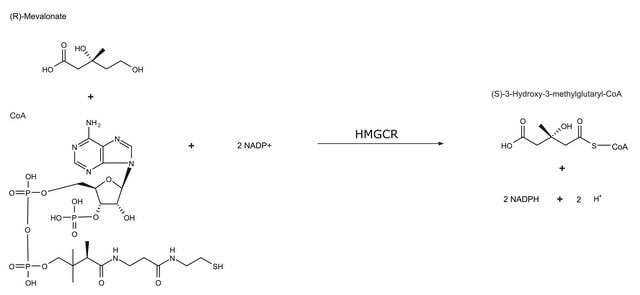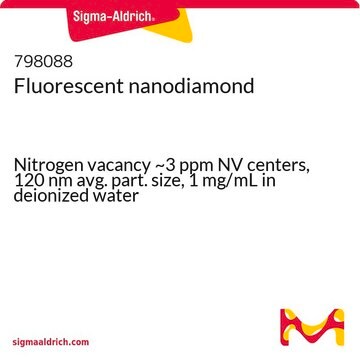CS1090
HMG-CoA Reductase Assay Kit
sufficient for 30 assays (1 mL), sufficient for 100 assays (200 μL)
Synonym(s):
HMGR Assay Kit
Sign Into View Organizational & Contract Pricing
All Photos(2)
About This Item
UNSPSC Code:
12161503
NACRES:
NA.28
Recommended Products
usage
sufficient for 100 assays (200 μL)
sufficient for 30 assays (1 mL)
Quality Level
shipped in
dry ice
storage temp.
−70°C
Gene Information
human ... HMGCR(3156)
Related Categories
General description
The HMG-CoA Reductase Assay Kit is an important tool for the basic research of cholesterol and other related metabolic pathways.
Application
The HMGR activity kit is designed for the detection of HMG-CoA reductase activity. A major function of the kit is to screen for various inhibitors and activators of the purified catalytic subunit of the enzyme, HMG-CoA reductase, which may play a crucial role in therapeutics. The assay is based on the spectrophotometric measurement of the decrease in absorbance at 340 nm, which represents the oxidation of NADPH by the catalytic subunit of HMGR in the presence of the substrate HMG-CoA.
Biochem/physiol Actions
HMGR (3-hydroxy-3-methylglutaryl-CoA reductase) is a transmembrane glycoprotein located on the endoplasmic reticulum. This enzyme catalyzes the four-electron reduction of HMG-CoA to coenzyme A (CoA) and mevalonate, which is the rate-limiting step in sterol biosynthesis. The activity of HMGR is controlled through synthesis, degradation, and phosphorylation in order to maintain the concentration of mevalonate derived products. In addition to the physiological regulation of HMGR, the human enzyme has been targeted successfully by drugs in the clinical treatment of high serum cholesterol levels. Controlling serum cholesterol levels has an important therapeutic role since hypercholesterolemia often leads to the development of atherosclerosis and subsequently to cardiovascular pathologies, which might result in myocardial infarction and stroke. It has been suggested that a disturbance of cholesterol homeostasis contributes to the development of a chronic inflammatory state.
Kit Components Also Available Separately
Product No.
Description
SDS
- N6505β-Nicotinamide adenine dinucleotide 2′-phosphate reduced tetrasodium salt hydrate, ≥95% (HPLC) 25 mgSDS
Storage Class Code
11 - Combustible Solids
Certificates of Analysis (COA)
Search for Certificates of Analysis (COA) by entering the products Lot/Batch Number. Lot and Batch Numbers can be found on a product’s label following the words ‘Lot’ or ‘Batch’.
Already Own This Product?
Find documentation for the products that you have recently purchased in the Document Library.
Customers Also Viewed
Huanjie Li et al.
Frontiers in cell and developmental biology, 8, 404-404 (2020-07-17)
Statins are widely used cholesterol-lowering drugs. Their potential application in anti-cancer treatment is also under investigation. The individual variance in statin response has been observed, which may be caused by the variation in human HMG-CoA reductase (hHMGR)-the inhibition target of
E S Istvan et al.
Biochimica et biophysica acta, 1529(1-3), 9-18 (2000-12-09)
In higher plants, fungi, and animals isoprenoids are derived from the mevalonate pathway. The carboxylic acid mevalonate is formed from acetyl-CoA and acetoacetyl-CoA via the intermediate 3-hydroxy-3-methylglutaryl coenzyme A (HMG-CoA). The four-electron reduction of HMG-CoA to mevalonate, which utilizes two
Rosana Aparecida Manólio Soares et al.
International journal of molecular sciences, 16(2), 4150-4160 (2015-02-19)
The objective of this study was to identify the major peptides generated by the in vitro hydrolysis of Amaranthus cruentus protein and to verify the effect of these peptides on the activity of 3-hydroxy-3-methyl-glutaryl-CoA reductase (HMG-CoA reductase), a key enzyme
Mohammad Azizur Rahman et al.
BioMed research international, 2014, 828149-828149 (2014-06-25)
Oxidation of low-density lipoprotein (LDL) has been strongly suggested as the key factor in the pathogenesis of atherosclerosis. Mushrooms have been implicated in having preventive effects against chronic diseases due especially to their antioxidant properties. In this study, in vitro
R Kleemann et al.
Current drug targets. Cardiovascular & haematological disorders, 5(6), 441-453 (2006-03-01)
Besides classical risk factors such as hypercholesterolemia and hypertension, chronic subacute inflammation has recently been recognized as an important force driving the development of atherosclerosis, the most common underlying cause of myocardial infarction and stroke. There is compelling evidence that
Articles
3-hydroxy-3-methylglutaryl-CoA reductase (HMGR) is a transmembrane glycoprotein, located on the endoplasmic reticulum.
Our team of scientists has experience in all areas of research including Life Science, Material Science, Chemical Synthesis, Chromatography, Analytical and many others.
Contact Technical Service












